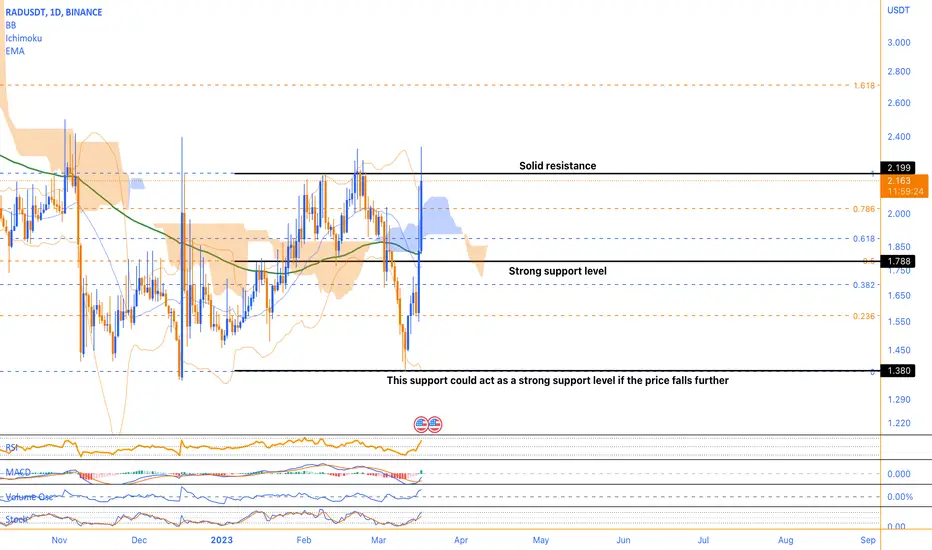Radicle (RAD) has been on a bullish run recently, gaining the most among other assets in the past 24 hours. The current price of RAD is $2.190, which is higher than the daily timeframe 1 Fibonacci level of $2.199, indicating potential resistance at this level.
However, the RSI of RAD is currently at 64.5, suggesting that there may still be room for the asset to gain in the short term. Additionally, the daily EMA 100 of $1.826 suggests that the asset is currently in a bullish trend.
Looking at the Fibonacci levels, the 0.5 Fibonacci level of $1.788 acted as solid support for the price of RAD during the recent bullish move. If the price continues to rise, the next resistance level could be the daily timeframe upper Bollinger band at $2.154.
The daily timeframe middle Bollinger band is currently at $1.767 and could act as a potential support level if the price experiences a pullback. On the other hand, the lower Bollinger band at $1.380 could also act as a strong support level if the price falls further.
The MACD of RAD is currently at -0.037, which suggests that there is currently no strong bullish or bearish momentum in the market. However, the stochastic oscillator is at 83, above the overbought level of 80. Traders should be aware that the stochastic oscillator can remain in overbought territory for extended periods during a strong bullish trend.
Overall, RAD appears to be in a bullish trend in the short term, with potential resistance at the daily timeframe 1 Fibonacci level and the upper Bollinger band. The support levels to watch are the 0.5 Fibonacci level, the daily timeframe middle Bollinger band, and the lower Bollinger band. Traders should also keep an eye on the RSI and stochastic oscillator for potential signs of overbought or oversold conditions.
However, the RSI of RAD is currently at 64.5, suggesting that there may still be room for the asset to gain in the short term. Additionally, the daily EMA 100 of $1.826 suggests that the asset is currently in a bullish trend.
Looking at the Fibonacci levels, the 0.5 Fibonacci level of $1.788 acted as solid support for the price of RAD during the recent bullish move. If the price continues to rise, the next resistance level could be the daily timeframe upper Bollinger band at $2.154.
The daily timeframe middle Bollinger band is currently at $1.767 and could act as a potential support level if the price experiences a pullback. On the other hand, the lower Bollinger band at $1.380 could also act as a strong support level if the price falls further.
The MACD of RAD is currently at -0.037, which suggests that there is currently no strong bullish or bearish momentum in the market. However, the stochastic oscillator is at 83, above the overbought level of 80. Traders should be aware that the stochastic oscillator can remain in overbought territory for extended periods during a strong bullish trend.
Overall, RAD appears to be in a bullish trend in the short term, with potential resistance at the daily timeframe 1 Fibonacci level and the upper Bollinger band. The support levels to watch are the 0.5 Fibonacci level, the daily timeframe middle Bollinger band, and the lower Bollinger band. Traders should also keep an eye on the RSI and stochastic oscillator for potential signs of overbought or oversold conditions.
Join our channel:
🔵 t.me/monocoin_public
🟠 t.me/monocoin_public
🔵 t.me/monocoin_public
🟠 t.me/monocoin_public
🔵 t.me/monocoin_public
🟠 t.me/monocoin_public
🔵 t.me/monocoin_public
🟠 t.me/monocoin_public
Disclaimer
The information and publications are not meant to be, and do not constitute, financial, investment, trading, or other types of advice or recommendations supplied or endorsed by TradingView. Read more in the Terms of Use.
Join our channel:
🔵 t.me/monocoin_public
🟠 t.me/monocoin_public
🔵 t.me/monocoin_public
🟠 t.me/monocoin_public
🔵 t.me/monocoin_public
🟠 t.me/monocoin_public
🔵 t.me/monocoin_public
🟠 t.me/monocoin_public
Disclaimer
The information and publications are not meant to be, and do not constitute, financial, investment, trading, or other types of advice or recommendations supplied or endorsed by TradingView. Read more in the Terms of Use.
